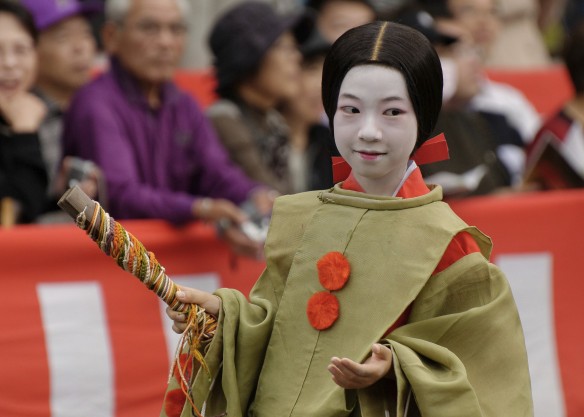NOTE: The Jidai Matsuri, or Festival of Ages is held every year on 22 October, the date Japan’s ancient capitol of Kyoto was founded. Here is an earlier post from when we attended the festival and parade. — Jadi
Uwe and I visited both China and Japan on a trip. We were startled when Japan felt much more foreign than China. For a First World country, Japan is opaque and surprisingly difficult to grasp.

We made sure we had plenty of time in Kyoto, traditionally Japan’s cultural heart.* Tokyo is modern and young and moves swiftly. Ancient Kyoto also seemed to have an older population, although the Kyoto train station was by far the most wonderfully futuristic we’ve ever visited. Our autumn visit coincided with the Jidai Matsuri, or Festival of Ages, held every year on October 22nd.
For a millennium Kyoto was the country’s capitol. In 1868 the emperor moved his imperial court to Tokyo. The Kyoto Prefecture was afraid that Kyoto’s thousand years of history would fade from memory. To make sure this didn’t happen they built the Heian Shrine to house the spirit of Emperor Kammu, who founded Kyoto in 794. The Jidai Gyoretsu, a parade for the Jidai Matsuri, was first staged in 1895.
Chairs are set up along the parade route and reserved well in advance. The parade started at noon at the Imperial Palace. We positioned ourselves on the grass 4.5 kilometers away, not far from the giant red torii gates of the Heian Shrine where the parade would end.
The parade commemorates the continuous ages of Kyoto history with truly spectacular costumes and objects. It begins with participants dressed in the styles of the Meiji Era (1868-1912) and then goes back in time to the Heian Era (794-1185). Musicians and buskers, riders on horse back and flag carriers all march.
The outfits are accurate from the samurai warriors’ headdresses and armor down to the last dot of face make up. Every detail has been researched.** Over 2,000 people take part in the parade.
The procession lasted for hours and Uwe took hundreds of photographs. Occasionally I made a run for bottles of water and snacks. We fell in love with onigiri, an ingenious salmon and rice treat wrapped in seaweed. It comes in a deceptively simple looking package that holds all of the ingredients separate until you open it.
I’ll need a separate post to talk about the shrines and temples we visited and the geishas we saw. Or to describe the cloths and scarves I bought, each with its special weaving technique and materials. Or the lacquerware bowls I fell in love with, first developed by monks as the perfect receptacle for rice…
NOTES: *Kyoto contains 17 World Heritage sites and is a UNESCO World Heritage City. **The methods used to make the costumes are traditional, too.
© Jadi Campbell 2017. All photos © Uwe Hartmann. Uwe’s photos of our trip to Japan and his photography may be viewed at viewpics.de. Go to my earlier post 8:15 A.M.to read more about our visit to Japan.
Additional information: http://www.lonelyplanet.com/japan/travel-tips-and-articles/77406#ixzz2zEtAXf7i or www.kyotoguide.com
Click here for my author page to learn more about my books and me.








What a wonderful post. It made me so excited for all the beauty and creativity in the world, and I had to show the fabulous photos to Don. I think this just influenced when we will be in Japan – whatever year it is it has to include Oct 22 in Kyoto.
Alison
Good to see your comment. That’s great news Alison! A friend who lives in Kyoto wrote that it rained this year. We had perfect warm sunny autumn weather when we were there. So you’ll want to take that into consideration. Also the seats along the roadside were 100% occupied. We were fine on the grass but for chairs you’ll want to book way ahead of time. PS: We LOVED Japan! Well worth a trip!
Thank You for sharing! Amazing. 🙂
That parade was perfect down to the teeniest detail…
Fascinating photos and history! The detail and colors in these costumes are amazing, and it’s wonderful to see traditions and history celebrated and enjoyed by so many people.
I also enjoyed your poem and Uwe’s photos. When we think of all the death and destruction the US has participated in around the world – well, I think about that every time I hear about 9/11.
Thanks, Marilyn. What astonished me about Hiroshima is the deep center of stillness. The events profoundly changed that place and people, and perhaps anyone who goes there to visit. Kyoto was great – if, as I said, opaque. A friend who lived in Japan told me the challenge was to try to “crack the code” of the very private inner Japan. A fascinating country and culture!
That last picture is stunningly beautiful.
Thanks! That photo now hangs on one of our walls. We’ll switch it out eventually, but I’m currently enjoying Uwe’s Japan pics for sure.
I wonder if China is easier to understand because they have spent the last couple of decades developing so many ties to US businesses. I’ll have to ask my sis (whose husband is Japanese, and who with him owns a business that has worked with Chinese businesses in the past)
You’ve nailed it, Brigid. China is open to the outside for business, while for hundreds of years Japan had limited contact. I personally wonder if China is so ancient and huge that they absorb Western ideas as simply another passing influence, while the much smaller Japan carefully safeguards their traditions and ways. Thanks for commenting here!
Wonderful pictures! Very clear.
Thanks! These were the cream of a very fine crop of photographs from Uwe.